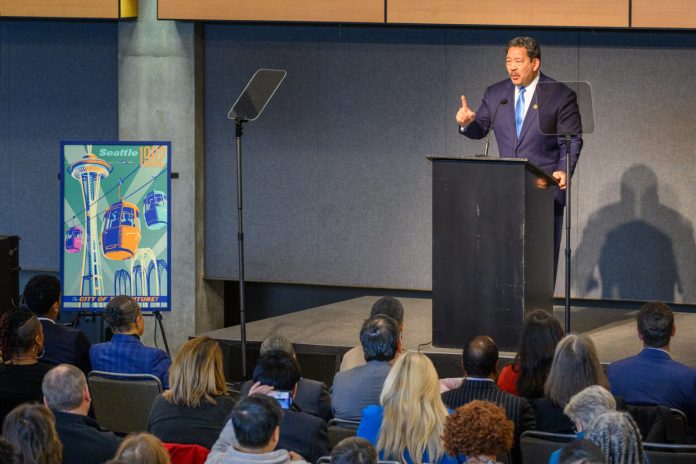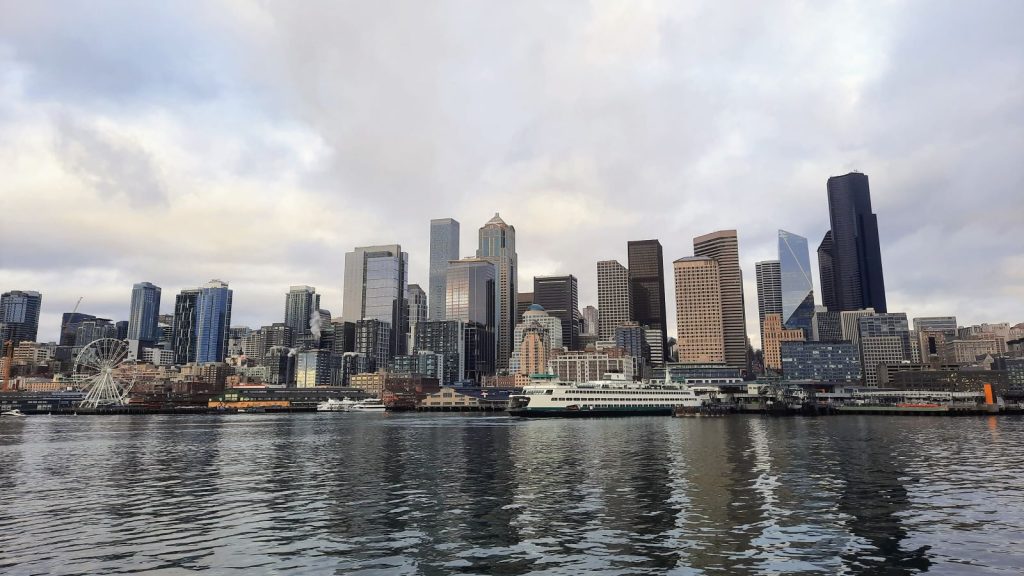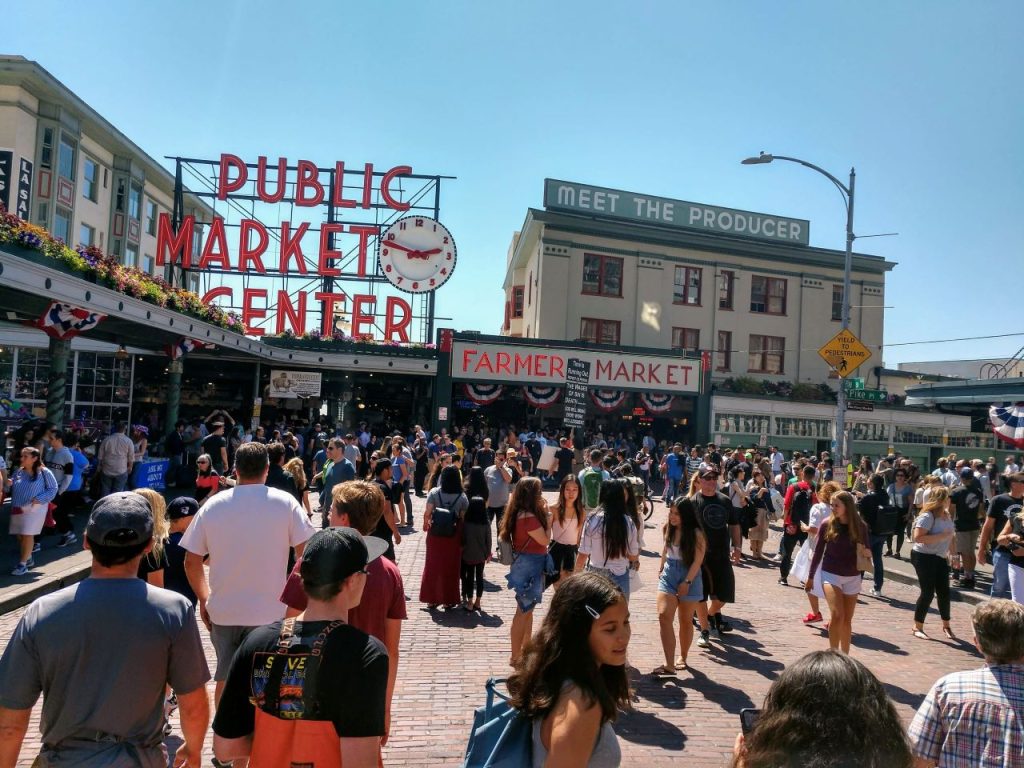
The mayor has coined splashy acronyms from DAP to CARE, but the programs themselves are lagging behind.
Mayor Bruce Harrell titled his state of the city speech as “the city of the future we’re building today,” but 14 months into his term, few of the Mayor’s plans have been fleshed out and put into action. Tuesday’s speech rolled out few new initiatives and was light on specifics.
While Harrell teased a Vision Zero road safety push, the actionable steps won’t be announced until a press conference in coming weeks. Similar story for the long-awaited “top-to-bottom” review of the Vision Zero program initiated by Harrell’s pick to lead the Seattle Department of Transportation (SDOT), Greg Spotts. That report was intended to be a 90-day review but hadn’t been released to the public in over a month as Spotts and the Mayor’s office hash out action steps and finetune their messaging. On Thursday, SDOT released the report, but still no word on the press conference.
Similarly, in coming months, Harrell promised a “downtown activation plan” or DAP focused on attracting more downtown residents and activity and lowering crime and drug abuse. “It may mean a linear arts-entertainment-culture district that connects downtown with multiple neighborhoods,” he said.
The Seattle Streetcar and the paused project to complete the missing Center City segment of system didn’t get a mention in the speech, but Director Spotts has painted Harrell as a big fan of his Cultural Connector concept to promote the streetcar project and jumpstart downtown recovery. The linear arts and culture district may dovetail with the streetcar, but the mayor made no promises and invoked more amorphous and piecemeal ideas around downtown activation.
“Activation and eyes on the street help create safety,” Harrell said. “That’s why our plan will light up our Downtown corners with artists and musicians, pop-up vendors, and social service workers and members of the faith community creating a proactively positive presence for all.”
Harrell didn’t have those program ready to roll out just yet, saying the deliberate pace was intentional. He then preemptively pushed back against critics.
“Some cynics may demand the exact blueprint for our entire downtown immediately,” Harrell said. “We need to do this right; it has to be sustainable; and we’re working seven days a week to deliver.”
As PubliCola‘s Erica Barnett wrote in her coverage of Harrell’s speech, more than a year into his mayoral term calling anyone expecting results already “cynics” is dismissive and hints at style over substance approach — “vibes” over tangibly advancing policy initiatives. “Despite strong #OneSeattle vibes, he offered only a few concrete steps,” Barnett noted.
Big hurdles to convert offices to housing
Among the bigger proposals was a design competition to advance conversions downtown office buildings to housing. The competition was promised to launch in March, but details were limited so far. There is ample reason to doubt office conversions will materialize, especially in significant numbers.
While Harrell cited zoning as an obstacle to office-to-housing conversions, downtown zoning is already extremely flexible and housing is permitted throughout the neighborhood. However, many office buildings have minimal compatibility with housing because the towers are too deep. In architecture lingo, Seattle offices have large floorplates that makes getting natural light in to the interior difficult. Even with workable floorplates, the expense of doing the conversion is considerable.

The costliness of office conversions is tied to the different demands of housing. While office workers don’t expect separate bathrooms and kitchens for each unit, apartment dwellers certainly do. Partitioning open floorplate offices into apartments takes adding walls and hallways and overhauling the electrical and heating, ventilation, and air conditioning (HVAC) systems in addition to the plumbing. It is impossible to ad some amenities, like balconies, for which downtown residents expect and will pay top dollar. None of this work is cheap, which has led some homebuilders to say you’re better off starting from scratch with a new building.
Stories of successful office conversion projects, including a recent Tacoma endeavor, belies that these are still exceptions rather than a fully formed trend in downtown real estate. Perhaps the most successful city in converting office space to housing is Los Angeles.
Josh Cohen highlighted LA’s success in a recent Crosscut feature on downtown revitalization efforts: “Los Angeles has had an adaptive-reuse ordinance in place since 1999 that has led to the creation of more than 12,000 apartments and condos. Washington, D.C. and Chicago have each added more than 1,000 units of apartments converted from offices since 2020.”
Since LA’s program has a bigger downtown to work with and 25 years to take effect, Seattle can realistically expect only a few hundred housing units created through office conversions per year if everything aligns. This is not nothing, but it’s also not enough to significantly impact Seattle’s housing shortage or its deficit in eyes on the street and patrons at downtown businesses. According to the real estate analytics firm CoStar, Seattle’s central business district office vacancy rate has reached 21%. While this is triple the pre-pandemic office vacancy rate, it hardly a full exodus with re-use opportunities on every block.
Of course promoting more housing in underused downtown office space clearly isn’t a bad idea. But tentatively jumping on the bandwagon at what might be the tail-end of a pandemic fad won’t necessarily get the job done. It’s going to take commitment and concerted effort to pull off. Will a design competition without further incentives be enough? Will this concept keep the Harrell administration’s attention or in a year’s time will it be on to the next fad and visioning exercise?
Urban planning guru Richard Florida pushed the office conversion idea as the keynote at the Downtown Seattle Association’s annual gala in March. Nearly a year later, Seattle hasn’t gotten the ball rolling. But with these promises of a design competition launching in March, the Harrell administration may be hoping the trend lasts long enough to capitalize — or if not that at least that it’s the thought that counts.

Throwing cold water on adaptive re-use ideas for downtown spaces gives no one pleasure. We certainly need creative ideas in this vein to get the most out of downtown. But getting more people to live downtown could also start with simpler, more tangible proposals to boost new housing production and activate the street space the city controls to make downtown more livable.
A pedestrianized Pike Place is long past due. Street festivals taking over commercial thoroughfares and bike-friendly ciclovía Sundays could put a new spin on downtown living. Wouldn’t you want to live next to a street bustling with human activity and green space rather than a forlorn car sewer? It’s not about just putting a busker or pop-up vendor out on a corner for a few hours at a time, but re-dedicating more street space to be people-oriented, walkable, and vibrant in perpetuity.
Design review hurdles and housing appeal snags have delayed handfuls of new proposals for downtown residential projects. While Harrell touted reforms to the City’s volunteer-run design review program, so far he’s only extended a pandemic-era pilot program that is little help to those projects. Broader reform to speed up design review and permitting has been painfully slow and tied up in a stakeholder process that the Office of Planning and Community Development (OPCD) isn’t managing well and seems designed (at least initially) to avoid big questions.
Police and new CARE Department
Harrell stressed policing in his speech as another key ingredient to jumpstarting downtown recovery. He gave a shoutout to Councilmember Alex Pedersen’s hard stance in favor of funding the Seattle Police Department (SPD) over other priorities, which led him to vote against the City budget in the fall.
“I want to thank Councilmember Pedersen for his unwavering support for a police department with the right number of officers and the right kind of officers,” Harrell said.
That no vote ended up being over a 1% reduction to SPD’s budget that did not impact staffing, but Pedersen and colleague Sara Nelson seized on it and used it pretext to oppose the budget. Harrell himself didn’t make a big deal about the SPD cuts at the time and stressed how well he and Budget Chair Teresa Mosqueda worked together to overcome a close a major budget hole, but Pedersen is getting a belated slap on the back now.
The “right number” of police officers seems to be a moving target that usually works out to ‘more than my political opponents say.’ Plus, turning political promises into reality isn’t always easy. Even with hiring bonuses Pedersen fought for and won, hiring has lagged behind targets due to a national shortage of police recruits and continued. Harrell’s fully-funded staffing plan aimed for a net gain of 30 officers over the biennium.
“I attended every single patrol rollcall to meet with officers – a modern first. I needed them to know how much I appreciate their strong public service,” Harrell added.
Those officer rollcalls aren’t without their controversy as some attendees leaked audio recordings of Harrell’s comments to the media that were a bit embarrassing and showed him to be much less collaborative in spirit. Instead of One Seattle collaboration, Harrell promised to bury his “thin resume” enemies and run opponents against them in 2023 Council elections in order to advance his agenda of jacking up SPD spending and aggressively removing homeless encampments.
As it turns out, four of seven councilmembers opted against running for reelection, leaving it largely up to open-seat races to determine the council’s makeup. The police spending posturing and heaps of praise for SPD hint that Harrell and his allies plan to make police spending a major attack line against progressive candidates, similar to last two elections.
Attempting to craft an all-of-the-above strategy, Harrell also pledged a “comprehensive white paper” laying out a path to stand up Civilian Assisted Response and Engagement Department or CARE Department. Such a civilian-led public safety department has been discussed and promised since the 2020 police brutality protests, but progress has been slow. SPD and the Seattle Police Officers Guild (SPOG) have been obstructing efforts to launch these alternative responses. The impasse has the attention of Councilmember Andrew Lewis, who has repeatedly underscored that other cities like Denver have overcome the obstacles and set up civilian emergency response programs with much less delay and hem-hawing about further analysis.
Continuing negotiations of the overdue police contract will have a huge say on whether the CARE Department gets off the ground and whether police accountability measures are ratcheted up after the last SPOG contract stripped them out. Harrell referenced the obstacle, but it’s unclear if he will go to the mat to overcome it. “One Seattle” vibes may sway a great many folks, but it’s hard seeing SPOG contract negotiators among them.
Doug Trumm is publisher of The Urbanist. An Urbanist writer since 2015, he dreams of pedestrian streets, bus lanes, and a mass-timber building spree to end our housing crisis. He graduated from the Evans School of Public Policy and Governance at the University of Washington in 2019. He lives in Seattle's Fremont neighborhood and loves to explore the city by foot and by bike.

